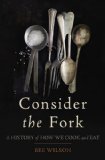Summary | Excerpt | Reading Guide | Reviews | Beyond the Book | Readalikes | Genres & Themes | Author Bio

Critics' Opinion:
Readers' Opinion:
First Published:
Oct 2012, 352 pages
Paperback:
Oct 2013, 336 pages
 Book Reviewed by:
Book Reviewed by:
Poornima Apte
Buy This Book
It is sometimes said that the earliest forks were all two-pronged. This is not so. Some very early forks have survived with four prongs (or "tines"), others with three, and a greater number with two. The number of prongs was an indication not of date but of function. Two prongs were best suited to impaling and stabilizing food—mostly meat—while it was cut (like the carving forks still sold as a set with carving knives). Three prongs or more were better if the fork was to be used as a quasi-spoon, for conveying food from plate to mouth. There were even experiments to push it to the limit with five-pronged forks (like the five-bladed razors that took over from the old two-bladed and three-bladed ones, claiming hyperbolically to be the most "technologically advanced" way for men to shave), but this was found to be too much metal for the human mouth to hold.
In the nineteenth century, two distinct methods emerged for handling a knife and fork. The first was christened by the great etiquette guru Emily Post as "zigzag" eating. The idea was to hold your knife in the right hand and fork in the left as you cut up everything on the plate into tiny morsels. You then put the knife down, seized the fork in the right hand, and used it to "zigzag" around the plate, scooping up all the morsels. At first, this method was common throughout Europe, but it later came to be seen as an Americanism, because the English devised a still more refined approach. In English table manners, the knife is never laid down until the course is finished. Knife and fork push against one another rhythmically on the plate, like oars on a boat. The fork impales; the knife cuts. The knife pushes; the fork carries. It is a stately dance, whose aim is to slow down the unseemly business of mastication. Both the Americans and the British secretly find each other's way of using a fork to be very vulgar: the British think they are polite because they never put down their knives; Americans think they are polite because they do. We are two nations separated by common tableware, as well as by a common language.
In the four hundred years since Thomas Coryate marveled at Italian meat-forks, our food has changed immeasurably, yet our dependence on the fork largely has not; we use them more now than ever. Like the colander, in use since ancient times, it is an example of a kitchen technology that has stuck. Although we may abandon it to munch a hamburger or to attempt to use chopsticks in a Chinese restaurant, the fork is entirely bound up with our experience of eating. We are so used to the sensation of metal (or plastic) tines entering our mouths along with food, we no longer think anything of it. But our use of forks is not inconsequential—it affects our entire culinary universe. As Karl Marx observed in the Grundrisse, "The hunger gratified by cooked meat eaten with a knife and fork is a different hunger from that which bolts down raw meat with the aid of hand, nail and tooth." Forks change not just the how of eating but the what.
Which is not to say that forks are always superior to other methods of eating. As with every new kitchen technology from fire to refrigeration, from eggbeaters to microwaves, forks have drawbacks as well as benefits. The Renaissance opponents of the fork were right, in many ways. Knives and forks are handy enough for cutting a slice of roast beef, but are more hindrance than help for eating peas or rice, which are better served by the humble spoon. Eating with a knife and fork carries with it a complacency that is not always justified. It is a very fussy way of eating food. We often overattribute efficiency to the technologies we are accustomed to. Because we use knives and forks every day, we do not notice how they hamper us. Our table manners require us to use two hands to perform with less dexterity what chopsticks can do with only one.
Excerpted with permission from Consider the Fork: A History of How We Cook and Eat, by Bee Wilson. Available from Basic Books, a member of The Perseus Books Group. Copyright © 2012. Further information available at: www.considerthefork.com





The Flower Sisters
by Michelle Collins Anderson
From the new Fannie Flagg of the Ozarks, a richly-woven story of family, forgiveness, and reinvention.

The House on Biscayne Bay
by Chanel Cleeton
As death stalks a gothic mansion in Miami, the lives of two women intertwine as the past and present collide.

The Funeral Cryer by Wenyan Lu
Debut novelist Wenyan Lu brings us this witty yet profound story about one woman's midlife reawakening in contemporary rural China.
Your guide toexceptional books
BookBrowse seeks out and recommends the best in contemporary fiction and nonfiction—books that not only engage and entertain but also deepen our understanding of ourselves and the world around us.